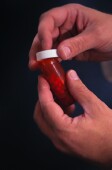
MONDAY, March 3, 2014 (HealthDay News) — One of every three Tennesseans fills a prescription for narcotic painkillers at least once a year, creating a free-floating pool of available medication that helps feed the state’s growing problem with prescription drug abuse, a new study has found.
Nearly 5.2 million Tennessee residents received painkillers — 37 million total prescriptions — between 2007 and 2011, which works out to about 1.4 prescriptions per resident, according to a report published online March 3 in the journal JAMA Internal Medicine.
A small but significant percentage of those residents appeared to be engaging in “doctor shopping,” which indicates drug abuse and increases their risk of overdose death, said senior study author Dr. Timothy Jones, state epidemiologist for the Tennessee Department of Health.
Among patients who received narcotic pain killers in 2011, 7.6 percent got prescriptions from more than four doctors and 2.5 percent went to more than four pharmacies to get their medication. Nearly 3 percent had an average daily dose of more than 100 morphine milligram equivalents (MME), considered a high-risk dosage.
“There is a pretty substantial subgroup of Tennesseans who are using multiple doctors, multiple pharmacies and getting very high doses,” Jones said.
A second new study appearing in the same journal found that having prescription narcotics around, even for legitimate purposes, helps fuel ongoing drug addiction.
Painkillers obtained from a friend or relative, either freely given or purchased, provide about half the prescription narcotics used by chronic abusers, according to the study by the U.S. Centers for Disease Control and Prevention.
“These drugs have risks, and sharing medications can share those risks and increase the risk that someone could overdose and die,” said lead author Christopher Jones, now a senior adviser in the Office of Policy and Planning at the U.S. Food and Drug Administration.
In Tennessee, overdose deaths due to prescription drugs increased nearly fivefold during the past decade, Tim Jones said, rising from 118 deaths in 2001 to 564 in 2011. There now are more deaths related to narcotic painkillers than heroin and cocaine combined, he said.
Prescription drug abuse in Tennessee began as a problem in the northeast part of the state, in and around the Appalachians, but since has spread to become a statewide health crisis, Tim Jones said.
State health officials worked with the CDC to analyze patient information from a state database that monitors prescriptions of controlled substances.
They found that people ran a six times greater risk of overdose death if they were engaged in doctor shopping, either by receiving prescriptions from four or more doctors or filling them at four or more pharmacies. People taking high doses of more than 100 MMEs on average were 11 times more likely to die from overdose.
People with one or more of these risk factors accounted for 55 percent of all overdose deaths, the researchers found.
In 2011, Tim Jones said, there were 32,000 Tennesseans who received 25 or more prescriptions for opiates, and 5,500 who got prescriptions from 10 or more doctors.
“That’s pretty hard to come up with a good explanation for,” he said. “If you’re getting that many prescriptions from that many doctors, you’re working pretty hard at it.”
The Tennessee findings become more disturbing when held next to a national U.S. study about the sources of illicit prescription drugs.
CDC researchers found that nearly two-thirds of people of people aged 12 and older who reported light nonmedical use of narcotic painkillers received the drugs for free from a friend or relative. The data came from an annual survey on drug use.
As use escalates to abuse — to the point at which people are taking narcotic painkillers 200 or more days a year — friends and family continue to be a major source of the drugs, with about 26 percent still freely given and another 23 percent purchased.
Those heavy users also rely on prescriptions from more than one doctor for 27 percent of their narcotic medications, and drug dealers for 15 percent.
“It is clear that as you require more and more drugs, you’re going to seek more and varied sources,” Christopher Jones said. “You are less likely to get [narcotics] from friends and family for free and more likely to get them prescribed by one or more physicians or buy them from a friend or relative or … drug dealer.”
Doctors can play a large role in controlling this form of drug abuse by using some healthy skepticism when considering a prescription, Tim Jones said.
“We have now made it mandatory that anytime an opiate prescription is written, the pharmacist who fills it has to put it in the database and physicians have to look when prescribing,” he said. “Now I can sit at my desk and look up their record and see that they’ve received prescriptions from five different doctors over the past five weeks. I can look them in the face and say, ‘I’m sorry, you’re not being truthful and you’re not getting it from me.'”
People also can help by properly disposing of medicine they no longer need, Christopher Jones said.
More information
For more about prescription drug abuse, visit the U.S. National Library of Medicine.
Copyright © 2025 HealthDay. All rights reserved.

